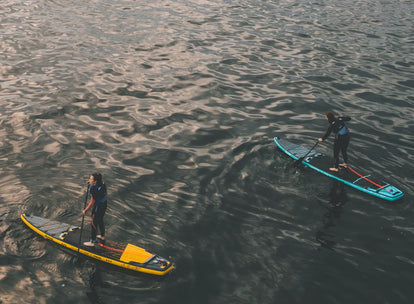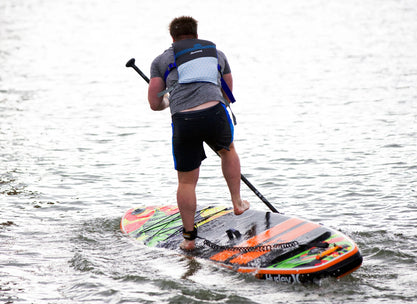If you’re anything like us, you’ll find the process of learning something new is more frustrating than it is rewarding – you just want to have the skill mastered in as little time possible so that you can enjoy the benefits and experiences it brings without the struggle.
If that sounds a bit like you, don’t worry; we’re not here to lecture you on ‘embracing the journey of learning’ – quite the opposite, in fact. We have developed a seven-day plan to help you master the art of paddle boarding in just seven days.
First, a bit of realism: of course, you’re not going to become a complete pro in just a week. But there’s no reason you can’t have the basics nailed, enabling you to have fun and at least give the impression that you’re something of a dab hand at paddle boarding.
Day 1: choose the right inflatable paddle board

If you’re going to give yourself half a chance of mastering the basics in a week, you’re going to have to make sure you’ve got the right kit.
Choosing between inflatable or solid boards is a primary consideration, with inflatables being more versatile, affordable and safer for beginners. The Aquaplanet MAX SUP is recommended for beginners due to its maximum balance on water.
Consider the board shape, such as surf, allround or flatwater/race, based on where you'll be paddling most. The Aquaplanet ALLROUND TEN SUP is a great versatile choice, while the Aquaplanet PACE SUP offers more stability and speed.
Board capacity matters for weight support and stability, with options available for various skill levels. For further assistance, you can use our paddle board calculator or contact our customer service team and they’ll answer any questions you have.
Day 2: Master the basic techniques

Here at Aquaplanet, next day shipping is available for orders placed before 12pm, Monday - Friday. So, there’s no reason you can’t order your board on the Monday and be out practicing on it by Tuesday.
Start on a calm and shallow body of water, like a lake or river, to practice the following essential skills:
Getting on the board: Begin in a kneeling position, placing your hands on the sides of the board. Gradually lift one knee and place your foot where your knee was, followed by the other foot. Keep your balance by placing your feet shoulder-width apart.
Standing up: Rise from the kneeling position to a standing position, ensuring your feet are parallel and centred on the board. Bend your knees slightly to maintain stability.
Paddling techniques: Hold the paddle with one hand on the handle and the other about two-thirds down the shaft. Dip the paddle into the water, pull it backward and then lift it out of the water once it reaches your feet. Alternate paddling on each side to maintain a straight course.
Turning: To turn left, paddle on the right side of the board. To turn right, paddle on the left side. You can also use a sweeping stroke by dragging the paddle blade back towards the tail of the board.
If you’re more of a visual learner, we’ve got videos of all of the above (and more) here.
Day 3: Learn how to assess the conditions

Staying safe while paddle boarding is of utmost importance to ensure an enjoyable and risk-free experience on the water. Firstly, always wear a properly fitted personal flotation device (PFD) or life jacket, regardless of your swimming ability.
Before setting out, check weather conditions, tides and currents to avoid any unexpected challenges. A good rule of thumb is: if something doesn't feel right or you’re unsure about the conditions, it's better to err on the side of caution and postpone your paddle boarding plans.
Paddle in areas suitable for your skill level and be mindful of your surroundings, keeping a safe distance from other watercraft and swimmers. Practice good paddle boarding etiquette and yield to others when necessary.
Consider taking a paddle boarding safety course local to you to learn valuable techniques and tips to handle different situations confidently.
Day 4: Learn advanced techniques

As you gain confidence, it's time to learn some advanced paddle boarding techniques:
Pivot turn: This manoeuvre allows you to turn the board quickly while maintaining stability. Use a sweeping stroke on one side of the board to pivot it around.
Cross bow turn: This turn involves moving to the nose of the board and using a sweeping stroke to turn the board while lifting the tail out of the water.
Back paddling: To slow down or reverse, paddle backward on both sides of the board.
Bracing: The bracing technique involves using your paddle as a support to maintain balance and stability in rough waters.
Day 5: Head out with a group

A quick Google search should bring you into contact with local paddle boarding groups (Facebook is another great place to look) – it’s well worth your time reaching out to them to understand the opportunities for getting involved.
Paddle boarding with others can boost confidence levels, particularly if you feel a bit uncertain about venturing out your own. The encouragement and camaraderie within the group create a positive environment for learning and trying new skills.
Being part of a group allows you to observe and learn from more experienced paddlers. You can pick up valuable tips, techniques and safety practices by watching how others navigate the water and handle different situations.
Day 6: Try some SUP yoga or SUP surfing

To take your paddle boarding skills to the next level, consider exploring SUP yoga or SUP surfing.
SUP yoga involves performing yoga poses on the paddle board, combining balance, strength and mindfulness. SUP surfing, on the other hand, involves riding small waves on your paddle board, requiring precision and agility.
SUP yoga and SUP surfing are obviously two very different vibes – but they’ll both challenge your paddle boarding abilities and enhance your overall experience on the water.
Day 7: Introduce someone else to paddle boarding

Introducing someone else to paddle boarding will reinforce what you've learned in the last seven days.
Demonstrating paddle boarding techniques to a beginner and answering any questions they might have requires you to put your knowledge into action. Repeating these demonstrations helps refine your own skills and muscle memory, enhancing your proficiency on the board.
Also, teaching others allows you to share the joy and excitement of the sport with someone else. This shared experience can deepen your passion for paddle boarding and strengthen your connection to the activity.
So, what you waiting for? Add your kit to your cart and let the crash course commence!


